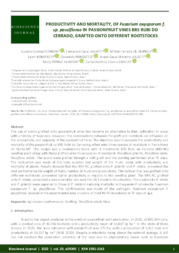Productivity and mortality, of Fusarium oxysporum f. sp. passiflorae in passionfruit vines brs rubi do cerrado, grafted onto different rootstocks
Productivity and mortality, of Fusarium oxysporum f. sp. passiflorae in passionfruit vines brs rubi do cerrado, grafted onto different rootstocks
Autoria: FERREIRA, L. G.; JULIATTI, F. C.; MORAES, M. F. de; KOBAYASTI, L.; RONCATTO, G.; JULIATTI, B. C. M.; ALMEIDA, R. F.; ARAÚJO, C. A. T.
Resumo: Absctrac: The use of scions grafted onto passionfruit vines has become an alternative to their cultivation in areas with a history of fusariosis. However, the combinations between the graft and rootstock can influence on the productivity and longevity of the passionfruit farm. The objective was to evaluate the productivity and mortality of the passionfruit cv BRS Rubi do Cerrado grafted onto three species of rootstock in Terra Nova do Norte-MT. The design was a randomized block with 4 treatments BRS Rubi do Cerrado (BRS-RC) seedling plant along with those grafted onto three species of rootstock: Passiflora gibertii, Passiflora alata; Passiflora nitida. The scions were grafted through a cleft graft and the planting performed after 70 days. The evaluation was made of the total number and weight of the fruits, along with productivity and mortality of plants. Results showed that the BRS-RC, grafted onto P. gibertii and P. nitida, presented the best performance for weight of fruits, number of fruits and productivity. The cultivar that was grafted onto different rootstocks presented higher productivity in regards to the seedling plant. The BRS-RC, grafted onto P. nitida, presented a zero-mortality rate over the 16.5 months of cultivation. The rootstocks P. nitida and P. gibertii were superior to those of P. alata in reducing mortality in the passionfruit vine by Fusarium oxysporum f. sp. passiflorae. The confirmation was made of the pathogen Fusarium oxysporum f. passiflorae isolated in the experimental area in scions of the BRS-RC inoculated at 70 days of age.
Ano de publicação: 2023
Tipo de publicação: Artigo de periódico
Unidade: Embrapa Agrossilvipastoril
Palavras-chave: Fusarium oxysporum f. sp. apii, Grafting (plants), Passiflora, Rootstocks
Observações
1 - Por padrão são exibidas publicações dos últimos 20 anos. Para encontrar publicações mais antigas, configure o filtro ano de publicação, colocando o ano a partir do qual você deseja encontrar publicações. O filtro está na coluna da esquerda na busca acima.
2 - Para ler algumas publicações da Embrapa (apenas as que estão em formato ePub), é necessário ter, no celular ou computador, um desses softwares gratuitos. Sistemas Android: Google Play Livros; IOS: iBooks; Windows e Linux: software Calibre.
Acesse outras publicações
Acesse a Base de Dados da Pesquisa Agropecuária (BDPA) para consultar o acervo completo das bibliotecas da Embrapa.

